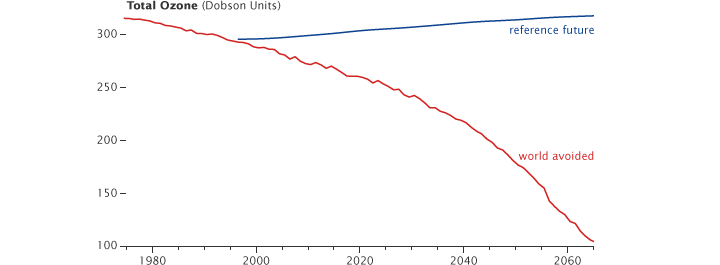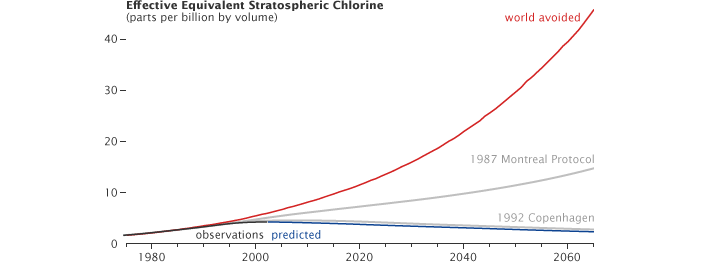What Is Wrong With The Ozone Layer? What Has Happened To Earth Because Of The Change?
What Might Have Been
In the new analysis, Newman and colleagues set out to predict ozone losses as if nothing had been done to stop them. The team started with the Goddard Earth Observing Organization Chemistry-Climate Model, an earth system model of atmospheric circulation that accounts for variations in solar energy, atmospheric chemical reactions, temperature changes and winds, and interactions betwixt the stratosphere, where ozone is found, and the troposphere, the layer of atmosphere closest to World. Their "globe avoided" simulation took months of estimator time to process.
The researchers permit global emissions of CFCs and similar compounds in the model world increase by three percentage per twelvemonth, the rate at which they were growing before regulation in the late 1980s. So they allow the simulated world turn from 1975 to 2065.

With continued production of CFCs, ozone levels worldwide would take dropped to dangerously depression levels. (NASA images by the GSFC Scientific Visualization Studio.)
By the simulated year 2020, 17 percent of global ozone is destroyed, and an ozone hole forms each year over the Arctic as well every bit the Antarctic. By 2040, the ozone "pigsty"—concentrations below 220 Dobson Units—is global. The UV index in mid-latitude cities reaches 15 effectually noon on a clear summer mean solar day (10 is considered extreme today).

Reckoner models predict that global average ozone will render to levels above 300 Dobson Units past 2064 (the reference futurity, blueish line). In dissimilarity, sustained increases in the level of CFCs and other ozone-destroying chemicals would have reduced global ozone below 100 Dobson Units (world avoided, red line). (Graph adapted from Newman et al., 2009.)

Global reduction in ozone levels would lead to a huge increase in unsafe ultraviolet (UV) radiations, with summer noontime UV alphabetize values at mid-latitudes ascent to 30—3 times the level currently considered extreme. (Graph adapted from Newman et al., 2009.)

"Our globe avoided adding goes a lilliputian beyond what I thought would happen," said Richard Stolarski, a member of the NASA team and pioneer of atmospheric ozone research. (NASA photograph by Robert Simmon.)
Surprising Collapse of Tropical Ozone Layer
In the 2050s, something foreign happens: ozone levels in the stratosphere over the tropics collapse to most zero in a span of half dozen years. According to Goddard scientist and study co-author Richard Stolarski, who was among the pioneers of atmospheric ozone chemistry in 1970s, the rapid, virtually-full ozone destruction is similar to what happens over Antarctica today.
Seeing a like process occur over the tropics was surprising, says Stolarski, "because we hadn't expected the tropical stratosphere would get cold enough to form stratospheric clouds." The dramatic cooling appears to be the event of ii processes. "Ozone absorbs UV energy, which causes the surrounding atmosphere to warm," explains Stolarski. "So, by itself, loss of ozone leads to cooling, which is something we expected to see."
More surprising, says Stolarski, is that the temperature modify intensified the stratosphere'south large-calibration, slow-moving circulation pattern. In that circulation, air from the lower stratosphere rises into the upper stratosphere at tropical latitudes, spreads toward the poles, and sinks. As air rises, information technology cools. As the circulation strengthened, the amount of cooling increased, allowing stratospheric clouds—today confined to polar latitudes—to form over the tropics. Delinquent ozone destruction followed.
By the terminate of the model run in 2065, global ozone drops to less than 110 DU, a 67 percent drop from the 1970s. Year-round Arctic polar values hover between 50 and 100 (down from 500 in 1960). The intensity of UV radiation at Earth's surface doubles; at sure shorter wavelengths, intensity rises by as much as x,000 times. Pare cancer rates would soar.
"Our world avoided calculation goes a little beyond what I thought would happen," said Stolarski. "The quantities may not be absolutely right, but the bones results conspicuously bespeak what could have happened to the atmosphere. And models sometimes testify you something y'all weren't expecting, like the precipitous drop in the tropics."
"We simulated a world avoided," said Newman, "and it'south a world we should be glad nosotros avoided."
The Real Earth
The existent world has been somewhat kinder. Product of ozone-depleting substances was finally halted in 1992, though their abundance is just showtime to decline because the chemicals tin reside in the atmosphere for fifty to 100 years. The peak abundance of CFCs in the atmosphere occurred around 2000, and has decreased by roughly iv percent to date.

Ozone-destroying chemicals ("Effective Equivalent Stratospheric Chlorine") would have increased steadily (red line) if the Montreal Protocol and later on agreements limiting CFCs and other chemicals had not been adopted (gray lines). Observations (black line) concur with the modeled results based on the latest restrictions. Ozone-destroying chemicals should approach pre-industrial levels around 2064. (Graph adapted from Newman et al., 2009.)
Stratospheric ozone has been depleted past 5 to 6 per centum at middle latitudes, but has somewhat rebounded in recent years. The largest recorded Antarctic ozone hole was recorded in 2006, with holes of slightly smaller size since then. Newman, Stolarski, and other colleagues have used their model to simulate how the real earth ozone layer volition recover as well. Because of climate alter from greenhouse gases, they say, the ozone layer will probably not look exactly like it did in the 1970s.

The Antarctic ozone pigsty (bluish areas), which first appeared in the early 1980s and peaked in the 2000s, is expected to shrink markedly past 2064. International agreements successfully mitigated the threat posed by CFCs and other ozone-destroying chemicals. (NASA images by the GSFC Scientific Visualization Studio.)
"I didn't remember that the Montreal Protocol would piece of work also as it has, but I was pretty naive most the politics," Stolarski added. "The Montreal Protocol is a remarkable international understanding that should be studied past those involved with global warming and the attempts to achieve international agreement on that topic."
-
Reference
- Newman, P. A., Oman, 50. D., Douglass, A. R., Fleming, E. L., Frith, S. M., Hurwitz, Yard. Chiliad., Kawa, S. R., Jackman, C. H., Krotkov, N. A., Nash, E. R., Nielsen, J. E., Pawson, S., Stolarski, R. S., and Velders, G. J. M. (2009). What would have happened to the ozone layer if chlorofluorocarbons (CFCs) had not been regulated? Atmospheric Chemical science and Physics, 9(6), 2113-2128.
-
Further Reading
- Aura: A Mission Dedicated to the Health of World'southward Atmosphere
- Climatic change and Atmospheric Circulation Will Make for Uneven Ozone Recovery
- Ozone Pigsty Watch
- Tango in the Atmosphere
- Un Environs Programme—Scientific Assessment Panel
- What Would Have Happened to the Ozone Layer if CFCs Had Not Been Regulated? (Multimedia)
Source: https://www.earthobservatory.nasa.gov/features/WorldWithoutOzone/page2.php
Posted by: garberherrinfold.blogspot.com



0 Response to "What Is Wrong With The Ozone Layer? What Has Happened To Earth Because Of The Change?"
Post a Comment